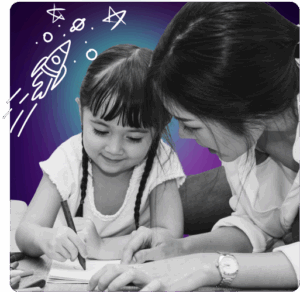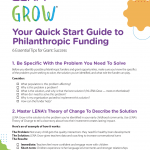What if we could turn the current challenges facing early childhood education into fuel for change?
Right now, keeping early childhood teachers in the profession is a serious problem. They face overwhelming stress. There’s an increase in challenging behaviors and assessment requirements. Not to mention wages that sometimes barely cover basic needs. Many entered the field with passion for nurturing and educating our youngest children, but that joy gets buried under financial strain and emotional exhaustion.
Burnout spreads as teachers struggle to manage wide-ranging behavioral needs without additional training or support. The profession that once felt rewarding now feels impossible. Which leaves children without the stable, caring relationships they desperately need to grow and learn.
Fixing all these problems overnight is impossible. Taking steps in the right direction isn’t.
The thing is, we have concrete evidence showing exactly which investments in early childhood education work. One of them may surprise you. Early childhood professional development programs offer a proven pathway to stability and growth — especially when they inspire confidence and help teachers reflect on their practice.
While others see crisis, forward-thinking leaders recognize opportunity. Smart leaders understand that uncertainty doesn’t mean retreat. It means strategic investment in what transforms child and teacher outcomes in early childhood education.
The Perfect Storm
Solutions arise from problems, right? Well, right now, there is a perfect storm of problems! Take a look:

- Compensation Crisis: Pre-K teachers earn $7,000-$24,000 less than comparable professionals. Other early educators and child care providers earn, on average, about $32K a year. And many are not offered benefits like health insurance, retirement, or overtime pay.
- Funding Crisis: Public funding for early childhood education creates a constant state of uncertainty. Programs face unpredictable budget cuts, delayed reimbursements, and shifting priorities that make long-term planning challenging. This instability forces directors to make tough choices with the money they have.
- Mental Health Crisis: Early childhood educators are experiencing unprecedented stress levels, burnout, and negative impacts on their mental health. So much so, they often leave the field completely.
- Training Gap: Teachers want to help children but often lack the right training. Many don’t learn how to handle challenging behaviors or how to support children dealing with big emotions. They may also benefit from training that tells them exactly why their profession is so important.
- Program Quality Deterioration: When teachers keep leaving, programs lose their rhythm and focus. Each new hire brings different ideas about how to teach, creating a patchwork of approaches instead of a unified vision. Children get mixed messages about routines, expectations, and learning goals. Quality improvement ratings suffer because programs can’t maintain consistent practices long enough to show real improvement. What should be a smooth, intentional learning experience becomes choppy and unpredictable — exactly the opposite of what young children need to feel secure and ready to learn.
What Children Lose When Teachers Leave
Teacher turnover breaks the bonds children need most. Research shows that when teachers leave, children lose critical gains in vocabulary, literacy, and emotional control.
Children also display more challenging behaviors. As a matter of fact, Head Start studies show that children become confused, long for missing teachers, and experience emotional stress that lasts months.
And language development? It takes the biggest hit. Each time a teacher leaves, children start over building relationships instead of advancing skills. The back-and-forth conversations that build brains get disrupted repeatedly.
This creates a harmful cycle. Stressed teachers struggle to help children, leading to poor outcomes that stress teachers even more. Without stable relationships, children can’t access the responsive interactions that shape their entire future.
Breaking this cycle requires one thing: keeping quality teachers in classrooms long enough for relationships to take root and flourish. And that’s something a high quality early childhood professional development program provides the ability for teachers to do.
What Teachers Gain From High-Quality Early Childhood Professional Development
How can we break the cycle? How can we reignite the joy that brought educators to the profession to begin with? How can we erase the stress that zaps them of that joy?
The best thing to do is invest well and invest often in early childhood educators. From crisis often comes a crystal-clear direction for where to invest.

Relationships are what suffer most in the perfect storm of problems in early childhood education. So why not start with the relationships? Why not give teachers professional development that helps them improve their relationships with the children in their care? Why not cut straight to the core of the power of early childhood education?
Good professional development can instill confidence. It can make teachers see the value of the important work they do. It can make them love their job again. It can make them stay.
What Everyone Gains When Teachers Have Access to High-Quality Professional Development
When teachers get quality training, everyone wins. Classroom interactions improve, leading to better communication between teachers and families. Parents see their children thriving, which builds trust in the program and the profession. As word spreads about excellent care, more families seek these services. Which expands access to high-quality early childhood education across communities.
Early childhood professional development does more than make teachers and caregivers happier. It reduces turnover. And it directly improves child outcomes and overall program quality. Research shows that 53% of how much children improve depends entirely on their teacher’s training quality. That’s a huge deal.
Long term returns make the case even stronger. According to RAND research, early childhood interventions boost academic achievement, improve behavior, and increase graduation rates.
And to think — all this can come from investing in a teacher’s career.
The Cost of Waiting
Every day without action creates bigger problems. Kindergarten readiness targets and third-grade reading goals go unmet. Children in low-income communities fall further behind. And just think about the cost to children’s brain growth. The first 2,000 days of life are a magical time for it. Research shows 90% of brain growth happens before kindergarten starts. Miss this window and catching up becomes much harder and more expensive.

Children won’t get these critical early years back. Their developing brains are forming connections right now that will shape their entire educational journey.
Seize This Moment
Crisis plus proven solutions plus economic incentives equals the perfect investment moment. While others retreat, forward-thinking decision makers act boldly.
Surviving budget cuts is only part of the path forward. The true path is about transforming early childhood education when change is most needed. Children in your community are counting on the conversations that shape their futures.
The time is now to transform uncertainty into opportunity and give every child the foundation they deserve.
Want to see how LENA Grow helps early childhood education programs thrive? Learn more about it here!



